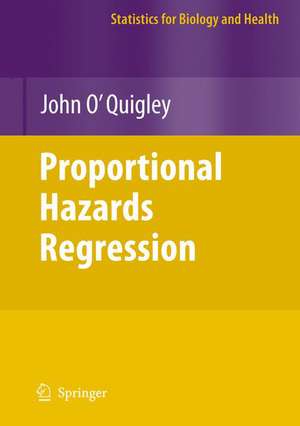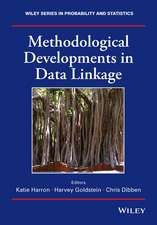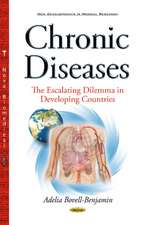Proportional Hazards Regression: Statistics for Biology and Health
Autor John O'Quigleyen Limba Engleză Hardback – 6 feb 2008
| Toate formatele și edițiile | Preț | Express |
|---|---|---|
| Paperback (1) | 709.77 lei 6-8 săpt. | |
| Springer – 25 noi 2010 | 709.77 lei 6-8 săpt. | |
| Hardback (1) | 657.39 lei 6-8 săpt. | |
| Springer – 6 feb 2008 | 657.39 lei 6-8 săpt. |
Din seria Statistics for Biology and Health
- 20%
 Preț: 633.23 lei
Preț: 633.23 lei - 17%
 Preț: 352.01 lei
Preț: 352.01 lei - 20%
 Preț: 776.71 lei
Preț: 776.71 lei - 20%
 Preț: 1376.32 lei
Preț: 1376.32 lei - 18%
 Preț: 1394.84 lei
Preț: 1394.84 lei - 18%
 Preț: 883.59 lei
Preț: 883.59 lei - 5%
 Preț: 843.91 lei
Preț: 843.91 lei -
 Preț: 397.16 lei
Preț: 397.16 lei - 20%
 Preț: 1002.67 lei
Preț: 1002.67 lei - 18%
 Preț: 1395.32 lei
Preț: 1395.32 lei - 5%
 Preț: 1102.10 lei
Preț: 1102.10 lei - 5%
 Preț: 874.83 lei
Preț: 874.83 lei - 18%
 Preț: 960.93 lei
Preț: 960.93 lei - 15%
 Preț: 585.90 lei
Preț: 585.90 lei - 5%
 Preț: 852.69 lei
Preț: 852.69 lei - 18%
 Preț: 903.62 lei
Preț: 903.62 lei - 5%
 Preț: 721.40 lei
Preț: 721.40 lei - 15%
 Preț: 653.46 lei
Preț: 653.46 lei - 18%
 Preț: 2114.90 lei
Preț: 2114.90 lei - 18%
 Preț: 1108.99 lei
Preț: 1108.99 lei - 5%
 Preț: 821.39 lei
Preț: 821.39 lei - 5%
 Preț: 849.02 lei
Preț: 849.02 lei - 15%
 Preț: 653.14 lei
Preț: 653.14 lei - 18%
 Preț: 958.56 lei
Preț: 958.56 lei - 5%
 Preț: 722.69 lei
Preț: 722.69 lei - 18%
 Preț: 728.74 lei
Preț: 728.74 lei - 18%
 Preț: 943.22 lei
Preț: 943.22 lei - 5%
 Preț: 1092.43 lei
Preț: 1092.43 lei - 15%
 Preț: 594.21 lei
Preț: 594.21 lei - 5%
 Preț: 377.87 lei
Preț: 377.87 lei - 18%
 Preț: 1124.60 lei
Preț: 1124.60 lei - 18%
 Preț: 1220.12 lei
Preț: 1220.12 lei - 15%
 Preț: 632.98 lei
Preț: 632.98 lei - 18%
 Preț: 1394.84 lei
Preț: 1394.84 lei -
 Preț: 389.11 lei
Preț: 389.11 lei - 18%
 Preț: 959.98 lei
Preț: 959.98 lei
Preț: 657.39 lei
Preț vechi: 773.41 lei
-15% Nou
Puncte Express: 986
Preț estimativ în valută:
125.79€ • 131.69$ • 104.08£
125.79€ • 131.69$ • 104.08£
Carte tipărită la comandă
Livrare economică 05-19 aprilie
Preluare comenzi: 021 569.72.76
Specificații
ISBN-13: 9780387251486
ISBN-10: 0387251480
Pagini: 542
Ilustrații: XVIII, 542 p. 41 illus.
Dimensiuni: 155 x 235 x 30 mm
Greutate: 0.89 kg
Ediția:2008
Editura: Springer
Colecția Springer
Seria Statistics for Biology and Health
Locul publicării:New York, NY, United States
ISBN-10: 0387251480
Pagini: 542
Ilustrații: XVIII, 542 p. 41 illus.
Dimensiuni: 155 x 235 x 30 mm
Greutate: 0.89 kg
Ediția:2008
Editura: Springer
Colecția Springer
Seria Statistics for Biology and Health
Locul publicării:New York, NY, United States
Public țintă
Adult: General. Academic/professional/technical: UndergraduateCuprins
Background: Probability.- Background: General inference.- Background: Survival analysis.- Marginal survival.- Regression models and subject heterogeneity.- Inference: Estimating equations.- Inference: Functions of Brownian motion.- Inference: Likelihood.- Inference: Stochastic integrals.- Inference: Small samples.- Inference: Changepoint models.- Explained variation.- Explained randomness.- Survival given covariates.- Proofs of theorems, lemmas and corollaries.
Recenzii
From the reviews:
"The book is clearly intended to be student-friendly. Each chapter begins with a section called Summary and a following one called motivation; each chapter ends with some exercises and class projects. … It is very carefully written, with detailed explanation and discussion everywhere. … I believe that the book can be thoroughly recommended to the student starting his research in the field and to the practitioner who needs to understand some of the theory." (Martin Crowder, International Statistical Review, Vol. 76 (3), 2008)
"The book is clearly intended to be student-friendly. Each chapter begins with a section called Summary and a following one called motivation; each chapter ends with some exercises and class projects. … It is very carefully written, with detailed explanation and discussion everywhere. … I believe that the book can be thoroughly recommended to the student starting his research in the field and to the practitioner who needs to understand some of the theory." (Martin Crowder, International Statistical Review, Vol. 76 (3), 2008)
Textul de pe ultima copertă
The place in survival analysis now occupied by proportional hazards models and their generalizations is so large that it is no longer conceivable to offer a course on the subject without devoting at least half of the content to this topic alone. This book focuses on the theory and applications of a very broad class of models—proportional hazards and non-proportional hazards models, the former being viewed as a special case of the latter—which underlie modern survival analysis.
Unlike other books in this area the emphasis is not on measure theoretic arguments for stochastic integrals and martingales. Instead, while inference based on counting processes and the theory of martingales is covered, much greater weight is placed on more traditional results such as the functional central limit theorem. This change in emphasis allows us in the book to devote much greater consideration to practical issues in modeling. The implications of different models, their practical interpretation, the predictive ability of any model, model construction, and model selection as well as the whole area of mis-specified models receive a great deal of attention.
The book is aimed at both those interested in theory and those interested in applications. Many examples and illustrations are provided. The required mathematical and statistical background for those relatively new to the field is carefully outlined so that the material is accessible to a broad range of levels.
John O’Quigley—Director of Research at the French Institut National de la Santé et de la Recherche Médicale and Professor of Mathematics at the University of California at San Diego—has published extensively on the subject of survival analysis, both in theoretical and applied journals. He has taught and carried out collaborative research at several of the world's leading departments of mathematics and statistics including the University of Washington, the Fred Hutchinson Cancer ResearchCenter in Seattle, Harvard University, and Lancaster University, UK.
Unlike other books in this area the emphasis is not on measure theoretic arguments for stochastic integrals and martingales. Instead, while inference based on counting processes and the theory of martingales is covered, much greater weight is placed on more traditional results such as the functional central limit theorem. This change in emphasis allows us in the book to devote much greater consideration to practical issues in modeling. The implications of different models, their practical interpretation, the predictive ability of any model, model construction, and model selection as well as the whole area of mis-specified models receive a great deal of attention.
The book is aimed at both those interested in theory and those interested in applications. Many examples and illustrations are provided. The required mathematical and statistical background for those relatively new to the field is carefully outlined so that the material is accessible to a broad range of levels.
John O’Quigley—Director of Research at the French Institut National de la Santé et de la Recherche Médicale and Professor of Mathematics at the University of California at San Diego—has published extensively on the subject of survival analysis, both in theoretical and applied journals. He has taught and carried out collaborative research at several of the world's leading departments of mathematics and statistics including the University of Washington, the Fred Hutchinson Cancer ResearchCenter in Seattle, Harvard University, and Lancaster University, UK.
Caracteristici
This text differs from most recent works in that it is mostly concerned with methodological issues rather than the analysis itself Includes supplementary material: sn.pub/extras














